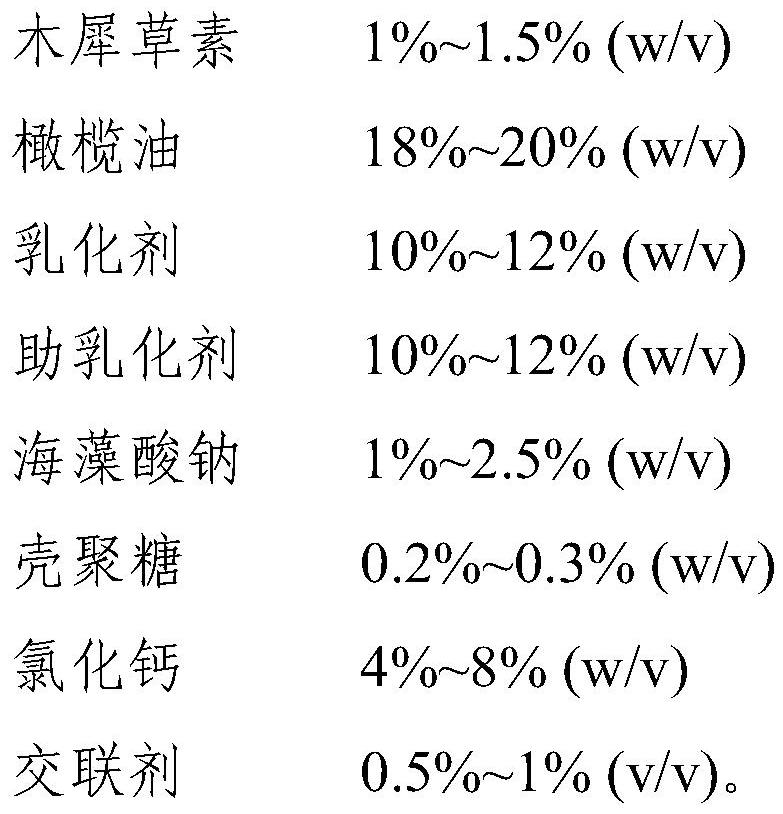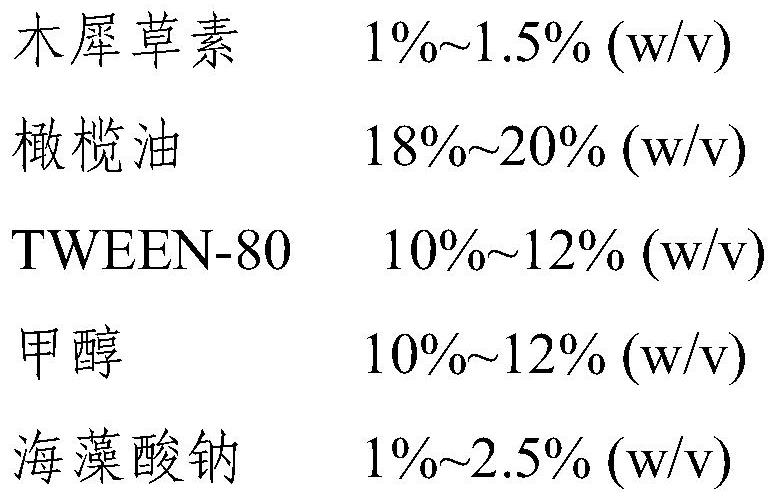A slow-release algae-inhibiting microsphere and its preparation method and application
A microsphere and slow-release technology, applied in the field of slow-release anti-algae microspheres and its preparation, can solve the problem of lack of long-term and high-efficiency inhibition effect of microcystin MCs, long-term and stable anti-algae growth effect, and complex production process and other problems, to achieve the effect of improving algae inhibition effect, embedding efficiency, and simple preparation process
- Summary
- Abstract
- Description
- Claims
- Application Information
AI Technical Summary
Problems solved by technology
Method used
Image
Examples
Embodiment 1
[0035] The present embodiment provides a slow-release algae-inhibiting microsphere, the raw materials of which include:
[0036]
[0037] Note: the above denominator v is the volume of the mixture of luteolin emulsification system and sodium alginate described in the preparation method of slow-release algae-inhibiting microspheres.
[0038] Chitosan 0.25%(w / v)
[0039] Calcium chloride 4% (w / v)
[0040] Note: The denominator v above (chitosan, calcium chloride) is the volume of the aqueous solution of chitosan and calcium chloride described in the preparation method of slow-release algae-inhibiting microspheres.
[0041] Glutaraldehyde 0.5% (v / v, denominator v is the total volume after the mixed solution of luteolin and sodium alginate is dropped into the aqueous solution of chitosan and calcium chloride described in the preparation method of slow-release algae-inhibiting microspheres ).
[0042] The preparation method of the above-mentioned slow-release algae-inhibiting...
Embodiment 2
[0049] Test of luteolin release characteristics of slow-release algae-inhibiting microspheres provided in Example 1:
[0050] Put 0.02 g / mL slow-release algae-inhibiting microspheres (containing 0.41 mg / mL luteolin equivalent) into the medium, and culture at 25±1 °C and 2000 lux of light (12 h light / 12 h dark).
[0051] By replacing the same amount of fresh medium every 1.5 days, the cumulative release of luteolin could be measured. The results showed that the release of luteolin increased to 171.79 μg / mL on the first day, and then decreased and stabilized at a lower level. Until the 49th day, there was a slight increase on the 10th to 13th day. The cumulative release amount from 22 to 49 days was 300.27-383.58 μg / mL, accounting for 73.32%-81.36% of the total content of luteolin in slow-release algae-inhibiting microspheres.
[0052] The actual concentration of luteolin released can be measured by sampling regularly without changing the medium. The results show that the avera...
Embodiment 3
[0054] The high-efficiency and lasting inhibitory effect of the slow-release algae-inhibiting microspheres provided in Example 1 on the growth of Microcystis was tested:
[0055] Tested algal species: Microcystis aeruginosa FACHB-915.
[0056] Methods: Microcystis in exponential growth phase was inoculated into BG11 medium, and the initial density of algal cells was 4×10 5 cells / mL, which is in line with the algal density during the bloom of Microcystis. According to the dose of luteolin in the slow-release algae-inhibiting microspheres and its release characteristics, the slow-release algae-inhibiting microspheres were added to the Microcystis culture solution to make The concentration reaches 0.004g / mL, and at the same time, it is set to contain 0.082mg / mL pure luteolin (equivalent to luteolin contained in slow-release algae-inhibiting microspheres) and 0.004g / mL blank microspheres (without luteolin). The microcystis culture solution and other treatment groups, and the Micr...
PUM
 Login to View More
Login to View More Abstract
Description
Claims
Application Information
 Login to View More
Login to View More - R&D
- Intellectual Property
- Life Sciences
- Materials
- Tech Scout
- Unparalleled Data Quality
- Higher Quality Content
- 60% Fewer Hallucinations
Browse by: Latest US Patents, China's latest patents, Technical Efficacy Thesaurus, Application Domain, Technology Topic, Popular Technical Reports.
© 2025 PatSnap. All rights reserved.Legal|Privacy policy|Modern Slavery Act Transparency Statement|Sitemap|About US| Contact US: help@patsnap.com



